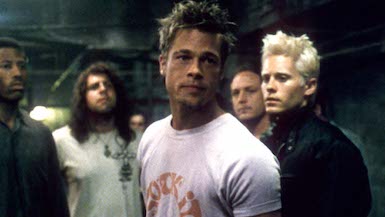|
|
The Number One Movie in America: Fight ClubBy Sean CollierJune 18, 2021
That explosion of home-viewing interest may have been a blessing and a curse. “Fight Club” became a cult staple with young men, many of whom firmly missed the point. Packaged inside a action-mystery-comedy, Fincher’s film is a full-throated indictment of masculinity, particularly the type that sprouts in all-male environments. (How many frat houses do you think gathered to watch the film, had a few beers and then decided to go a few rounds in the basement?) Its mysterious pseudo-protagonist, Tyler Durden, is the subject of the film’s ire and derision; any close viewing at all reveals that his dime-store philosophy is preposterous. There’s no coherent structure to his musings. Yet Durden became something of an antihero. (If “Fight Club” has a significant flaw, it’s making Durden so cool and funny — a project helped considerably by the face and body of Brad Pitt — that aspirational viewers might’ve missed that he was a monster.) When he gets around to coining, or at least popularizing, the term “snowflake,” in a speech that was promptly taken literally rather than as the nihilistic gobbledygook that it is, you realize that this movie landed exactly the wrong way for a lot of people. That’s part of the meta-narrative, though; let’s not get away from the fact that “Fight Club” is awesome. Smart, funny, entertaining, daring, sexy — when someone tells you that “Fight Club” is their favorite movie, you don’t blink. It’s worthy of adulation and, 22 years later, status as a pillar of cinema. Even if a lot of people missed the point. Maybe they should’ve followed the first two rules. “Fight Club” is the subject of the latest episode of The Number One Movie in America, a look back at past box-office champions. Each episode’s film is drawn at random from a list of every number-one movie since 1977. Please listen and subscribe! Next time: Are Sundays for church, or kicking off your day-appropriate shoes?
[ View other Number One Movie in America articles ]
[ View other columns by Sean Collier ]
[ Email this column ]
|

|
|
|

|
Friday, November 1, 2024
© 2024 Box Office Prophets, a division of One Of Us, Inc.


